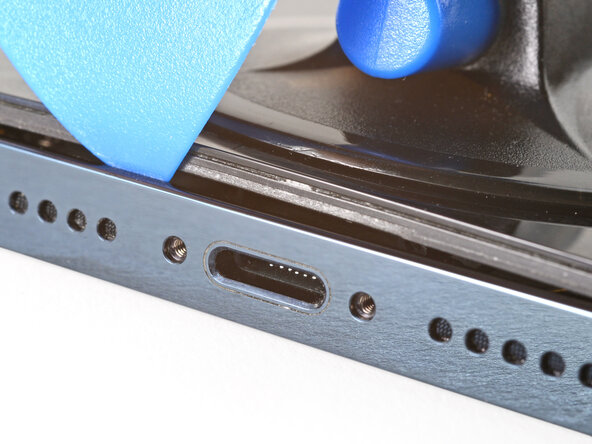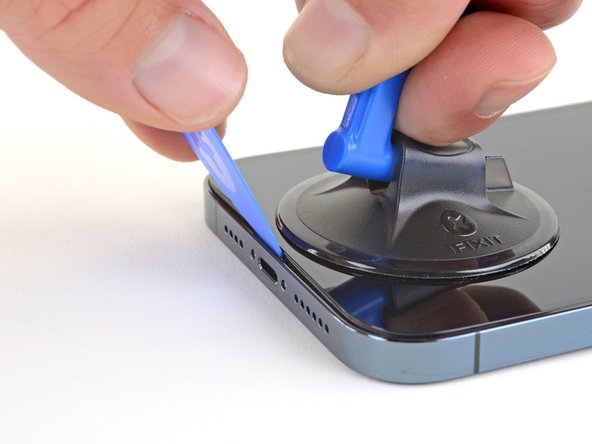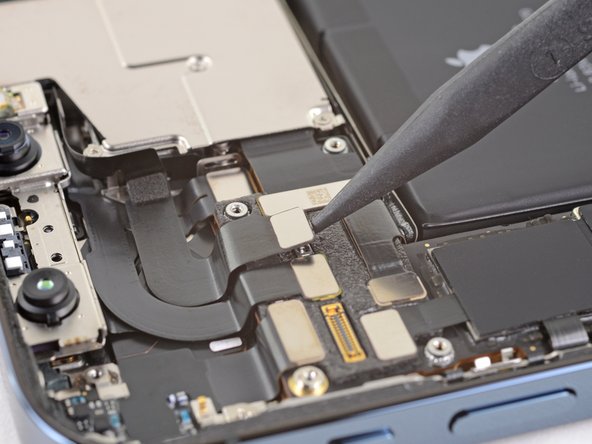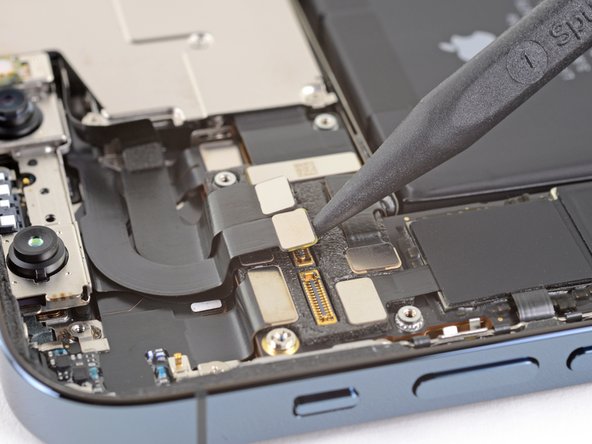iPhone 12 Pro Front-Facing Cameras Replacement
Duration: 45 minutes
Steps: 32 Steps
Heads up: Face ID will be out of commission after this repair.
Ready to swap out your iPhone 12 Pro's selfie camera? This guide walks you through replacing the front camera assembly. Heads up: installing a new camera disables Face ID, unless you have Apple’s magic touch—or you’re running iOS 18 or newer, where you can recalibrate genuine front cameras with Apple's Repair Assistant. If you’re just looking to get your selfie cam back in action, you’re in the right place.
Step 1
Heads up! Before diving in, make sure to drain that iPhone battery to below 25%. A fully charged lithium-ion battery can be a bit dramatic and might catch fire or explode if it gets a little poke. Safety first, friends!
Cracking open your iPhone’s display is basically a farewell party for its waterproofing. If you want to keep things splash-proof, grab some fresh seals before moving on. Skipping the seals? No biggie—just keep your phone away from any surprise water encounters when you put it back together.
- Shut down your iPhone before you get hands-on with the insides.
- Take out the two pentalobe P2 screws (6.75 mm long) sitting at the bottom edge of your iPhone.
Step 2
Pushing the opening pick in too far is a no-go—it can mess up your device. Mark the pick so you know when to stop and keep things safe.
Want to get fancy? Mark each corner of your pick with different measurements for max precision.
Or, for extra flair, tape a coin 3 mm from the tip of your pick to act as a handy stop sign.
- Mark the opening pick 3 mm from the tip with a permanent marker to keep your edge on point.
Step 3
Pop on some safety glasses to keep your eyes safe from any rogue glass bits that might pop loose during the repair.
Cracked screen? Grab some tape and cover the glass to keep those shards in line and your fingers in one piece.
If that suction cup just won’t cooperate, a dab of superglue will make it stick like it means business.
- Grab some clear packing tape and lay overlapping strips over the iPhone's screen until you've got the whole face covered – it’s like giving your phone a shiny new outfit!
- If the suction cup isn't sticking like you hoped in the next few steps, no worries! Just fold a sturdy piece of tape (like duct tape) into a little handle and lift the screen with that instead. You've got this!
Step 4
The next few steps show you how to use the Anti-Clamp, a nifty tool we've created to make opening up your device a breeze. If you're not using the Anti-Clamp, no worries—just skip ahead a few steps to see an alternative method.
For the full scoop on how to use the Anti-Clamp, check out this handy guide.
If your iPhone's surface is being a little too slippery for the Anti-Clamp to get a good grip, a bit of tape can help create some friction and keep it steady.
- Pull the blue handle back to unlock the Anti-Clamp’s arms—easy does it!
- Slide the arms onto either the left or right side of your iPhone.
- Place the suction cups near the bottom edge of your iPhone—one on the front, one on the back.
- Press the cups together to create a strong grip where you need it.
Step 5
- Slide the blue handle forward to lock those arms in place.
- Give the handle a full 360-degree turn clockwise, or keep going until the suction cups start to stretch a bit.
- Keep an eye on the suction cups to make sure they stay lined up. If they start to drift out of sync, just loosen them a bit and realign the arms.
Step 6
Take it easy and twist just a quarter turn at a time. Give it a minute between each turn and let the Anti-Clamp do its thing. You've got this!
Looking for more tips on how to use a hair dryer like a pro? Check out this guide for the full breakdown.
If the Anti-Clamp isn't creating enough of a gap, don't worry! Just give the area a little more heat and twist the handle a quarter turn to get things moving.
- Set your iPhone on something solid, like a hardcover book, so it sits hands-free and level—makes the next steps way easier.
- Grab a hair dryer and gently warm the bottom edge of the iPhone. It should feel just a bit too toasty to touch.
- Pause for a minute so the adhesive can loosen and a tiny gap appears.
- Slide an opening pick under the plastic screen bezel once that Anti-Clamp has created enough space.
- Skip the next three steps—they're not needed here.
Tools Used
Step 7
Keep that hair dryer moving, folks! Don't let it camp out in one spot for too long.
- Grab a hair dryer or heat gun and warm up the bottom edge of your iPhone for about 90 seconds, or until it feels just a little too hot to handle. You’re looking for that sweet spot of warmth, not lava-level heat!
Tools Used
Step 8
- Grab that single suction handle and stick it on the bottom edge of your phone, but don't go too close to the very edge of the glass. We want to keep things safe and sound!
Tools Used
Step 9
Slide the opening pick gently under the thick plastic bezel to keep your screen safe from any accidental nicks. Look for a clear gap—if the pick catches or you don’t see one, give the screen a little more lift and try again.
The adhesive keeping the screen snug and secure is pretty tough! Getting that initial gap open might take a bit of muscle. If you're struggling to make progress, don't worry! Just add a little more heat and gently wiggle the screen up and down. This will help loosen the adhesive until you've got just enough space to slip your tool in there.
- Grab the suction cup and pull up steadily with some solid pressure to gently loosen the screen from the frame.
- Slide an opening pick in at a sharp angle into the gap you've created.
Step 10
- Bust out your hair dryer and warm up the right edge of your iPhone (yep, the side with the power button) for about 90 seconds, or until it feels just a bit too hot to comfortably touch.
Tools Used
Step 11
Be careful not to insert your pick more than 3 mm deep – you don’t want to accidentally mess with anything important inside!
- Gently slide the opening pick around the bottom right corner of your iPhone to break that pesky adhesive seal.
- Keep the momentum going as you glide up the right edge of the iPhone until you reach the top right corner.
- Once you get to the top right corner, just leave the pick there for a moment before proceeding.
Step 12
- Grab a hair dryer and warm up the top edge of your iPhone for about 90 seconds, or until the screen feels just a bit too toasty to keep your finger on it comfortably.
Tools Used
Step 13
Keep your pick insertion under 3 mm to avoid messing with those top sensors!
- Glide your opening pick around the top right corner of your iPhone to loosen up that stubborn adhesive.
- Park the pick in the top left corner for now and keep charging ahead.
Step 14
- Grab your hair dryer and warm up the left side of your iPhone for about 90 seconds, or until it feels a bit too toasty to touch. That heat helps loosen things up!
Tools Used
Step 15
Be careful! There are some sensitive cables hanging out along the left edge of your iPhone. Avoid sticking your pick in this area, or you might accidentally give those cables a bad day.
Step 16
Go easy with the twisting—slow and steady wins this race.
Stubborn adhesive? Give the left edge another round of heat.
- Pop a second opening pick into the bottom left corner of your iPhone. It's like finding the perfect groove!
- Gently twist both picks at the same time—this will help those left-edge clips release smoothly. Keep it steady and you’re almost there!
Step 17
Hold off on fully separating the display just yet! There are still a few delicate ribbon cables keeping it connected to the iPhone's logic board. Take your time, no need to rush!
- Rotate your iPhone so the right edge is facing you. This way, it's easier to work with.
- Now, pop open the iPhone by lifting the display up from the right side, just like opening a book. Nice and smooth!
- Pro tip: Lean the display against something sturdy to keep it propped up while you work on the phone. It’ll make life a lot easier!
- When you’re putting everything back together, gently lay the display in place. Start by aligning the clips along the top edge, then carefully press the top edge down first. If it doesn’t snap into place easily, check the clips around the edges. Are they bent? Give them a quick look to make sure everything’s in tip-top shape before finishing up.
Step 18
Keep a close eye on every screw during this repair and make sure each one returns to its original spot—mixing them up could cause trouble for your iPhone.
- Take out the two 1.1 mm Y000 screws holding down the battery and display connector cover.
- When putting everything back together, it's a perfect moment to power on your iPhone and check that all functions are working before sealing the display. Remember to fully shut it down again before you keep going.
Step 19
- Pop off the cover to get started.
Step 20
Be careful not to mess up the black silicone seal around this and other board connections. These little guys work hard to keep water and dust out, so treat them with some respect!
- Grab a spudger or your trusty clean fingernail and gently lift that battery connector up from its cozy spot on the logic board.
- Give the connector a slight bend away from the logic board. This little move will keep it from accidentally touching the socket and powering up the phone while you're in the zone fixing things.
Tools Used
Step 21
- Grab a spudger or your trusty fingernail to gently disconnect the display cable connector. You've got this!
- When you're ready to reconnect, align the connectors just right. Press down on one side until you hear that satisfying click, then do the same on the other side. Remember, no pressing in the middle! Misalignment can lead to bent pins, and we definitely don't want that. If you're feeling unsure, just know that you can always schedule a repair for expert help.
Tools Used
Step 22
- Grab a spudger or your trusty fingernail and gently wiggle that digitizer cable connector free. You got this!
- If your screen starts acting a bit moody and refuses to respond to your touch after the repair, just disconnect the battery for a moment. Then, pop that connector back in place, ensuring it clicks snugly and is free from any pesky dust or obstructions. You're doing great!
Tools Used
Step 23
- Grab your Y000 driver and take out the four screws that are holding the front sensor connector cover in place.
- Unscrew the three tiny 1.1 mm-long screws.
- Now, carefully remove the single 1.4 mm-long screw.
Step 24
- Flip the cover up from the left side until the tiny clip on the right pops out.
- Lift off the cover and set it aside.
- When putting it back together, hook the right-side clip into its slot first, then swing the rest of the cover down into place. Easy does it!
Step 25
- Gently pop off the front sensor assembly cable connector using a spudger or your fingernail—like you're opening a secret snack compartment.
Tools Used
Step 26
- Lift off that display assembly like it’s the lid to your favorite snack container.
- If you're reassembling and want extra waterproof superpowers, now’s a great time to stick some fresh adhesive around the display edges.
Step 27
- Grab your Y000 driver and carefully unscrew the tiny 1 mm screw holding the front-facing camera assembly in place.
Step 28
- Gently pop off the front-facing camera bracket and set it aside like a boss.
Step 29
- Gently pry open the Face ID dot projector cable using a spudger or your fingernail, carefully disconnecting it from its home on the logic board. Take your time, you’ve got this!
Tools Used
Step 30
- Gently pry up the Face ID sensor cable from its connector on the logic board using a spudger or your fingernail.
Tools Used
Step 31
- Carefully nudge those Face ID cable connectors away from the logic board to reveal the selfie cam connector hiding underneath. It's like playing hide and seek, but you're winning!
- Next up, disconnect the selfie camera by gently prying its connector straight up. Keep it cool and steady, and you'll be one step closer to victory!
Step 32
- Give your new part a quick side-by-side with the old one—sometimes a little leftover hardware or sticky backing needs to make the jump to your upgrade.
- Put everything back together by reversing the steps above. Easy does it!
- If your replacement part calls for it, you might want to run a quick calibration. On iOS 18, check Settings→General→About→Parts & Service History, tap Restart & Finish Repair, and follow the prompts. Your device gets a fresh start!
- Done with old parts? Don’t let them clutter your drawers—drop them off at an R2 or e-Stewards certified recycler.
- If things didn’t go exactly as planned, try some classic troubleshooting, or pop over to our iPhone 12 Pro Answers community and see what’s up. And if you ever need a hand, you can always schedule a repair.









































































